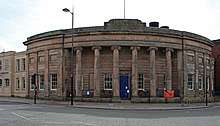Clark Rampling
Clark Rampling (bapt 6 April 1793 – buried 7 March 1875) was an English architect who worked from offices in London[1] and from about 1820 in Birkenhead, Cheshire (now in Merseyside). By 1841 he was joined in partnership in Birkenhead by his nephew Robert Bushell Rampling and the practice was known as C. and R. B. Rampling.
His best known work is the Liverpool Medical Institution, which was built in 1835–37 in Neoclassical style.[2] This building is recorded in the National Heritage List for England as a designated Grade II* listed building.[3] Earlier, he had designed the Church of St Mary, Birch, a Commissioners' church in Gothic Revival style, (c. 1827/28) which has since been demolished.[4] Other works in Cheshire and Lancashire include
- 1832 Villas at Mill Bank, Nr. West Derby
- 1833/35 Birkenhead Town Hall
- 1834 House for Spencer Jones, West Derby
- 1837 The Fish Hall, Murray Street, Liverpool
- 1830/40 Estate cottages, Caldy, West Kirby
- 1840 Magistrates' offices, Birkenhead
- 1840 St John the Evangelist, Buglawton, Congleton
- 1845 Market etc., Birkenhead
Clark Rampling died in 1875 in Tranmere, which is now in Merseyside.[1]
References
- Felstead, Alison; Franklin, Jonathan (2001), Brodie, Antonia (ed.), Directory of British Architects, 1834-1914, 2, Continuum International, p. 435, ISBN 9780826455147, retrieved 9 November 2012
- Sharples, Joseph; Pollard, Richard (2004), Liverpool, Pevsner Architectural Guides, New Haven and London: Yale University Press, pp. 12, 213, ISBN 0-300-10258-5
- Historic England, "Liverpool Medical Institution (1208429)", National Heritage List for England, retrieved 9 November 2012
- Port, M. H. (2006), 600 New Churches: The Church Building Commission 1818-1856 (2nd ed.), Reading: Spire Books, p. 334, ISBN 978-1-904965-08-4
